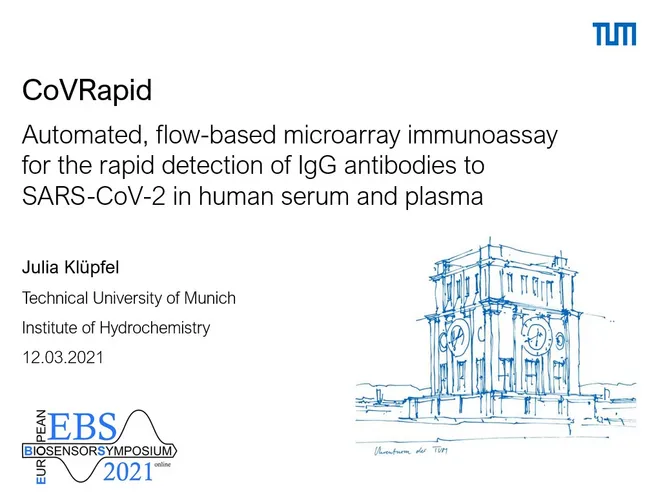"CoVRapid - Automated, flow-based microarray immunoassay for the rapid detection of IgG antibodies to SARS-CoV-2 in human serum and plasma"
Abstract
When first cases of infection with a formerly unknown respiratory virus, SARS CoV 2, were reported in December 2019, it was not to be expected that one year later we would still fight SARS-CoV-2. A valuable tool to assess immunity to the virus are antibody tests, and even more now, that first vaccines are available. The currently available antibody tests, however, have several drawbacks like being laborious and time-consuming. To overcome these drawbacks, we developed a rapid, flow-based chemiluminescence microarray immunoassay (CL MIA). This CoVRapid CL MIA allows for the simultaneous analysis of IgG antibodies to three different SARS CoV 2 antigens. We succeeded in covalently immobilizing these three antigens (S, N and RBD) on glass microarray chips in their native conformation. Subsequently, an indirect non-competitive immunoassay is done on the microarray chips within the analysis device Microarray Chip Reader 3 (MCR 3). Measurement results then are available in under eight minutes in a fully automated fashion.To prove the diagnostic performance of the test, we performed measurements for a sample set of 32 SARS CoV 2 serology negative and 33 positive samples. Optimized cut-off values were determined to classify samples as positive or negative. They allowed for a correct classification of all 65 samples were defined using receiver operating characteristic (ROC) curves. With these optimized cut-off values, all 65 samples could be classified correctly, resembling 100% diagnostic sensitivity and specificity and even outcompeting two commercial tests applied to the same sample set. We therefore have developed a powerful diagnostic tool for SARS CoV 2 serosurveillance that also holds promise to better characterize immune responses and link them to disease patterns or vaccination efficiency for this new viral infection.
Online presentation at the virtual European Biosensor Symposium (EBS).
TH Wildau in march this year with 250 participants-congratulations Julia!
